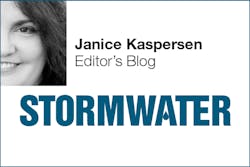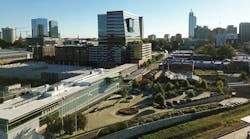
Many cities intend, or at least hope, to expand their use of green infrastructure to help manage stormwater and in some cases to reduce combined sewer overflows. Fewer, though, have a comprehensive plan for how to implement, monitor, and maintain these new installations, let alone how to pay for them. Developers might want to—or feel pressured to—include elements of green infrastructure in their projects, but again the specifics of how to do that are sometimes lacking.
St. Paul, MN, has taken steps to make the process clearer. This article from MetroLab includes an interview with three of the people involved: Wes Saunders-Pearce, water resource coordinator, and Michael Solomon, treasurer, both from the city of St. Paul; and Jerry (Zhirong) Zhao, associate professor and director of the Institute for Urban and Regional Infrastructure Finance at the Humphrey School of Public Affairs at the University of Minnesota. They start by explaining what green infrastructure is—still a nebulous concept to many people.
The city’s efforts are remarkable in part because they’re not, strictly speaking, necessary. “Often green infrastructure programs are the result of federal requirements,” says Saunders-Pearce. “But for St. Paul, where our sewer systems already meet federal code and are not mandated to change, shifting to using stormwater as a resource is completely voluntary.”
Another promising development is the city’s plan for funding new projects, in part through public-private partnerships. “The city is developing a funding framework—the Green Infrastructure Financing District concept—that captures development-related fees from future neighborhoods to pay for the comprehensive green infrastructure that will serve them and provide for increased flexibility in developing the surrounding property,” says Saunders-Pearce. “City staff have developed a proposed system to recover the costs of green infrastructure from the private development that benefits from shared, stacked-function green infrastructure systems. The capital costs will be recovered through connection fees imposed at the time building permits are issued, and the operation and maintenance costs will be recovered through dedication of stormwater system service charges and a special green infrastructure surcharge. The goal of this funding system is to assure sustainable funding to recognize the costs and value of green infrastructure within a defined district.”
The city plans to include in its stormwater utility fee code a “green infrastructure connection surcharge” and a “green infrastructure operation and maintenance surcharge.”
As Solomon notes in the article, “To move [green infrastructure] forward—especially on a district-wide scale—the city would take on some of the risk and upfront costs of infrastructure installation. We know we’ll be able [to] recoup those capital, operational, and maintenance costs. But of course, it needs to be set up correctly—we are using this research partnership to investigate the most equitable way for the fee to be set, the legal and technical mechanisms to do so, and finally the financial projections model of where the district approach ends up 10 or 20 years down the road.”
You can read the complete article here.
About the Author
Janice Kaspersen
Janice Kaspersen is the former editor of Erosion Control and Stormwater magazines.

